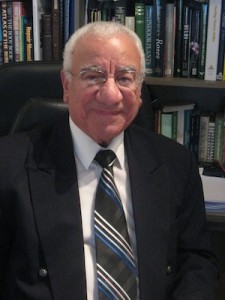SWEP Founder and Chairman
E.H. (Ted) Mikhail MSc, BSc Agric., Dip Land Recl. & Improv., Dip Agric Ext. MAIAST MRACI DG
 SWEP Founder & Chairman
SWEP Founder & Chairman
Ted Mikhail began his career as an Agronomist in Egypt in 1959, working first in Animal Husbandry and then in Soil Improvement. While in Egypt, he obtained his first degree in Agriculture at the Cairo University (1959), followed by his Post-graduate Diploma in Soil Science from the University of Alexandria (1966) – sponsored by the Ford Foundation, to study under several of the most eminent soil scientists in the World.
In 1967, Ted came to Australia and began research on improved irrigation methods with the Victoria State Rivers & Water Supply Commission. He then moved to the State Chemistry Laboratory as a research scientist focusing on the relationship between the chemical and physical properties of soils throughout Victoria. During this time, Ted furthered his studies at the University of Melbourne with a Diploma of Agricultural Extension (1975) and a Master of Agriculture (Soil Chemistry & Physics) in 1979. He also authored and co-authored more than sixty bulletins, research papers and reports.
He has been a member of the Australian Institute of Agricultural Science & Technology since 1968 and a member of the Royal Australian Chemical Institute since 1981.
In 1980 he established SWEP Analytical Laboratories in order to better serve the agricultural community by applying his principles in soil, plant, animals and human relationships to achieve the highest quality in life through our soil. He was then also able to extend his research to soils from around the World. In 1986, this all came together into what we now call “The Mikhail System”.
Since the very beginning, Ted has held strongly to the view that soil is a “Living System” and, as such, healthy soil should have an optimal balance of factors pertaining to each of its three main components – physical structure, plant nutrients and soil biology. Each of these components should be in balance, both in itself and with each of the others. He explains this view by comparing soil to the Human Being (as a more familiar example of a Living System). In this way, the structure of the human body begins with the skeleton (requiring Calcium, Magnesium and Phosphorus in proper proportions), just as the foundation of soil structure is cation balance (Ca, Mg, Na, K and H).
The skeleton is the framework upon which the tissues and muscle of the body is built (with the right balance of carbohydrates, protein and fat). So too, agricultural productivity is built upon the balanced availability of soil nutrients – Nitrogen, Phosphorus and Potassium. But healthy people also need vitamins and minerals. Likewise, crops and pasture need trace elements.
To complete this picture, it must be recognised that people do not live in sterile bubbles, but need the right balance of ‘good bacteria’ to aid digestion and help stave off infection. Similarly, biological balance is required in the soil to help in the cycling of nutrients and protect against pathogens.
This vision of the soil as a Living System, “The Mikhail System”, has been borne out both by research and field experience and is now recognised Worldwide for its effectiveness and reliability. Read more on the Mikhail System here.
